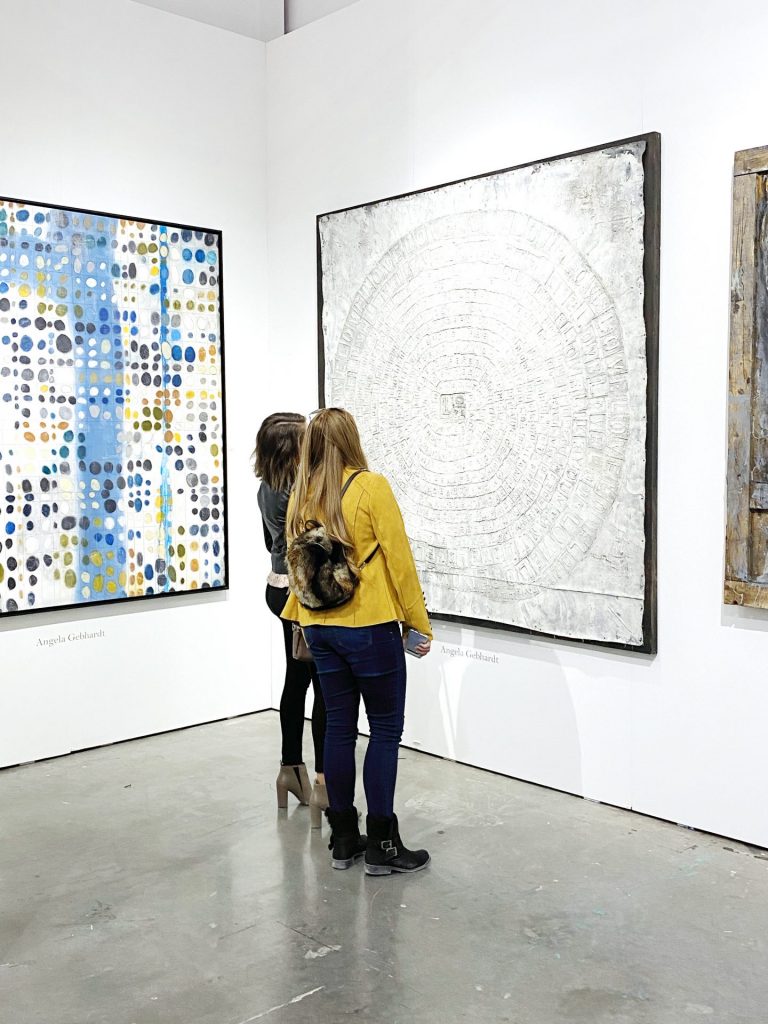Best Ways to Learn How to Talk About Art
Throughout the career of any creative person, the need to talk well-nigh your art is always nowadays. Gallerists and curators will want to know why they should piece of work with you lot, clients volition want to know the story behind the art and how your aesthetic fits with what they want, fifty-fifty friends at dinner parties volition desire a glimpse into what it is you do as an artist and what message you are trying to convey.
Positioning yourself and your art is not ordinarily an artist's strength. Self-promotion is something that makes many artists—especially the more than sensitive and introverted—extremely uncomfortable, and the marketing side of the fine art business organisation is oftentimes avoided similar the plague or hastily unloaded to someone else whenever possible.
Just the fact of the thing is, no one is ever going to intendance as much most your success as an artist as y'all volition. Y'all know your fine art more intimately than anyone, and therefore take a bird's eye view into the power and meaning of your fine art. However, articulating the things you intuitively understand almost your own work is not so simple. In fact, it tin be downright daunting.
You demand to exist able to intermission your work downwards simply into a succinct and accurate snapshot of who you lot are as an artist and what your art is all nigh—and you need to be able to do this for a variety of different audiences. Your explanation of your work should speak to curators, gallerists, and collectors as well every bit to the average person who may not exist well-versed in "art speak."

The Lift Pitch
There is a common concept in the business organisation world known as the "elevator pitch." This is the notion that you should be able to pitch yourself, product, business, etc. in the time it takes to make an elevator ride—well-nigh 30 seconds. Audio impossible? It's not. One time you've got a formula in place for how to best describe yourself and what you do, you'll find talking near your art becomes much easier and you'll see the positive results in your career as your professional communication skills increase.
The Importance of Pitching Yourself
Every bit an artist, one of the primary reasons we create art is to articulate something that cannot be said any other way. We set up most creating a manifestation of an abstraction—a thought, a feeling, an idea, an experience—and believe that the piece of work should speak for itself.
And all good art does. Art that transforms, inspires, and enlightens says then much more than we could convey by words alone.
So why must we speak most it? Why not let the art speak for itself?
Because for art to do the transformative work information technology'south meant to do, it needs to go far front of human eyes. And in society to get in front of homo eyes, it needs to get past the gatekeepers. And the gatekeepers have business plans, curating strategies, marketing statistics, and a lesser line. Non to mention a host of other artists who are also constantly vying for their attention.
Use your elevator pitch to hook the interest of their rational minds and let the power of your art do the residuum. Don't autumn into the trap of thinking you can skip the important step of pitching your work to the ears of those who can make a difference in your career.

Developing Your Elevator Pitch
So where exercise you start? Art is such a vast subject and your journey as an creative person so complex, knowing where to begin tin be the hardest part. Let's walk through a few components to get the ball rolling:
i. Discover What is Essential
What is the primary factor near your piece of work that if left out, would leave you feeling as if your work had become lifeless or had lost meaning? What is the essential element that compelled you to create this piece or collection? What is the thing you most want people to see and sympathise when they look at the artwork? This essential component could be the driving force around a particular drove, your entire philosophy as an creative person, or a single significant slice.
Spend some time brainstorming about what your essential element is until you lot can sum information technology up in a few sentences. This is the nucleus of your creative vision and lets the listener know who you are and what you are about without a lot of flowery language.
two. Don't Make Things Upwardly
Speaking of flowery linguistic communication, if you are asked something about your fine art that you're not sure how to answer, it'southward okay to acknowledge you lot don't know. Creating fine art is an innate, intuitive process; it isn't meant to be as comprehensible and analyzable as a table of data generated by automatic systems. It is far better to exist honest about yourself, your process, and what your fine art means to yous than it is to create a word salad of hyperbole in the hopes yous will seem impressive. Authenticity trumps illusion when it comes to making an impact with explanations of your work.
three. Focus Beyond the Visually Credible
Anyone who is looking at your work volition be able to tell what colors yous used, what textures are at that place, and so forth. When yous are talking about your work, you don't want to merely signal out what is right in front of their eyes. Attempt to add together something to the experience past offering them something they tin can't get from simply looking. Give them a behind-the-scenes look at what brought this art to life.
4. Avoid Hyperbole
While you do want to limited the authentic process and meaning of your art, you don't want to get lost in your own sense of poetry, expounding on the ethereal to the indicate of completely losing your audience. It can be easy to become carried away, using language that is meant to impress but may have the opposite effect of making y'all appear pretentious and disingenuous.
5. Keep it Positive
Some artists may feel a tad embittered by the necessity of focusing on the business concern side of art when all they want to do is create. As a result, they can autumn into speaking nigh their art irately because they resent having to explain themselves and their work. This approach is non likely to brand y'all many friends—or sales either. While the idea of the "difficult" or "dramatic" artist has been ingrained in pop culture, the art world is a globe of professionals similar whatever other and edifice a reputation for yourself as beingness belligerent, angry, or difficult to work with volition damage yous much more than assist you.
6. Practice Aloud
It may experience silly, simply practicing aloud can tremendously boost your confidence and help put you lot at ease when it comes time to talk about your art. The goal is non to memorize a script or sound overly rehearsed, simply to accept idea through and expert your chief speaking points so that they can be spoken easily, accurately, and with confidence.
Conclusion
Talking almost your art is something you will likely be required to exercise many times in the course of your career. However, it doesn't take to be daunting or frustrating. By spending some fourth dimension thinking through what the essential elements are to your work and your creative philosophy, being accurate, avoiding negativity and hyperbole, and practicing until your language flows freely, you will be able to talk about your fine art confidently to any audience who views your work.
Author Bio
Alia Sinclair is a author, poet, musician, and Editor-in-Chief of Patchwork Mosaic , an online mag for creatives. She is an avid fine art enthusiast and lives on the W Coast with her e'er-increasing library of books.
Source: https://artbusinessnews.com/2020/05/how-to-talk-about-your-art/
0 Response to "Best Ways to Learn How to Talk About Art"
Post a Comment